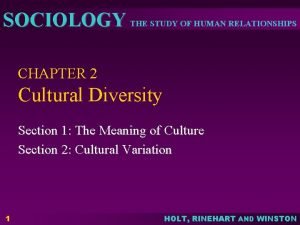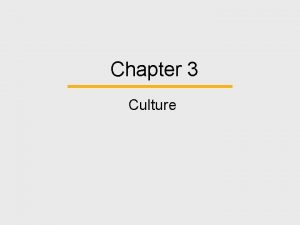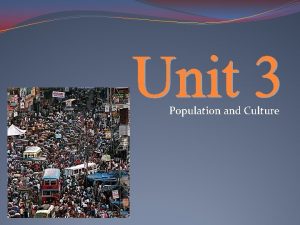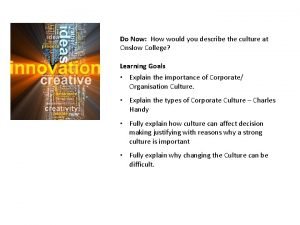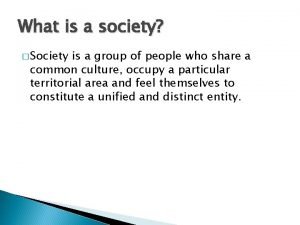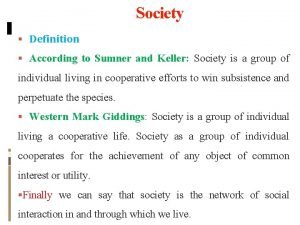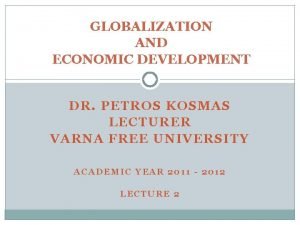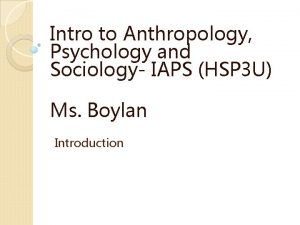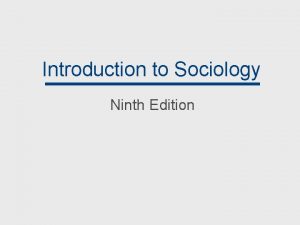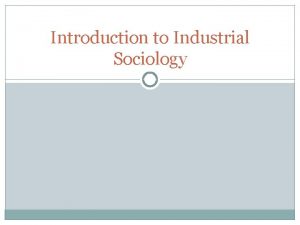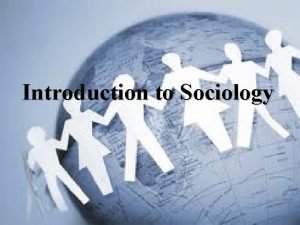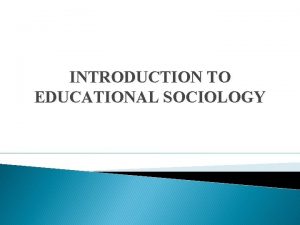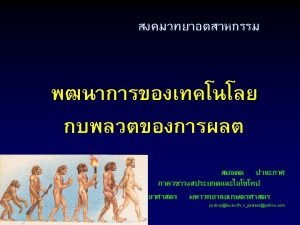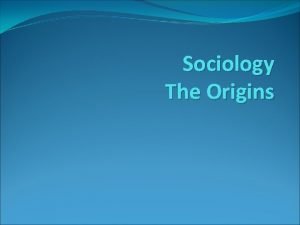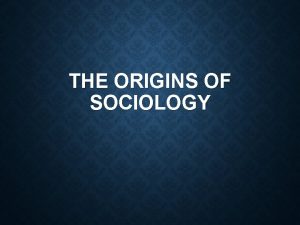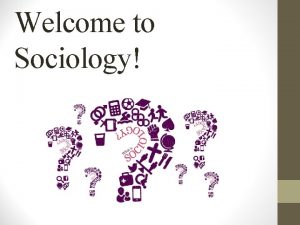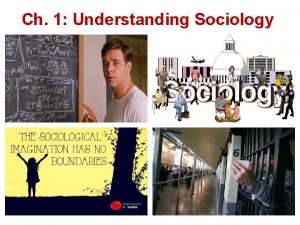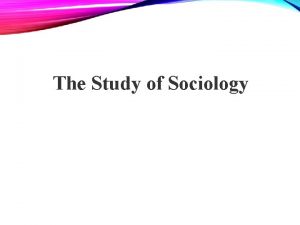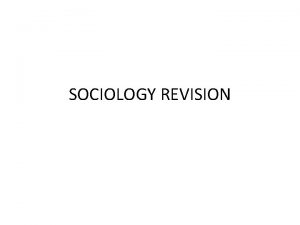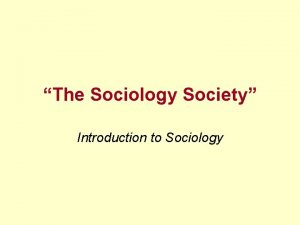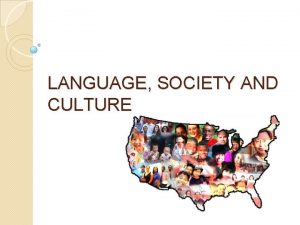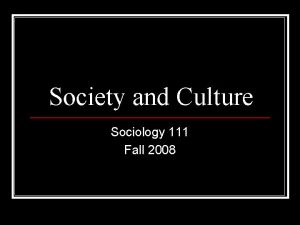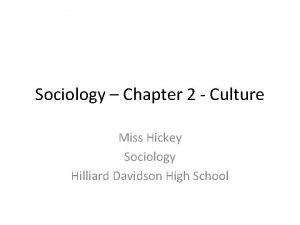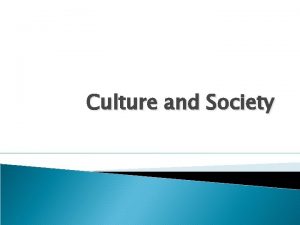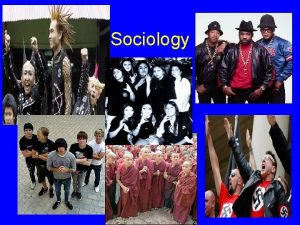Culture and Society Introduction to Sociology Society and
























- Slides: 24

Culture and Society Introduction to Sociology

Society and Culture • Culture: shared beliefs, values, and practices • Society: people who live in a definable community and who share a culture

Material and Nonmaterial Culture • Material culture: the objects or belongings of a group of people • Nonmaterial culture: the ideas, attitudes, and beliefs of a society

Cultural Relativism and Cultural Universals • Cultural relativism: the practice of assessing a culture by its own standards, and not in comparison to another culture • Cultural universals: patterns or traits that are globally common to all societies

A few -isms to Avoid in Sociology • Xenocentrism: a belief that another culture is superior to one’s own • Ethnocentrism: the practice of evaluating another culture according to the standards of one’s own culture • Cultural imperialism: the deliberate imposition of one’s own cultural values on another culture

Values and Beliefs • Values: a culture’s standard for discerning what is good and just in society • Beliefs: tenets or convictions that people hold to be true

Ideal vs. Real Culture • ideal culture: the standards a society would like to embrace and live up to • real culture: the way society really is based on what actually occurs and exists

Norms • Norms are the visible and invisible rules of conduct through which societies are structured • May be formal (written rules or laws) or informal • May be mores (morally weighted) or folkways (customs)

How do Societies Enforce Norms? • social control: a way to encourage conformity to cultural norms • sanctions: a way to authorize or formally disapprove of certain behaviors

Language, Culture, and Thought • Language: a symbolic system of communication • Symbols: gestures or objects that have meanings associated with them that are recognized by people who share a culture • Sapir-Whorf hypothesis: the way that people understand the world based on their form of language

High Culture vs. Popular Culture • high culture: the cultural patterns of a society’s elite • popular culture: mainstream, widespread patterns among a society’s population

Subcultures and Countercultures • subcultures: groups that share a specific identification, apart from a society’s majority, even as the members exist within a larger society • countercultures: groups that reject and oppose society’s widely accepted cultural patterns

Cultural Change Cultures change when something new (say, railroads or smartphones) opens up new ways of living and when new ideas enter a culture (say, as a result of travel or globalization)

Types of Societies Sociologists generally classify societies along a spectrum of their level of industrialization— from preindustrial to postindustrial

Practice Problem Order these societies on a spectrum of increasing technology: 1. Agricultural societies rely on farming as a way of life 2. Feudal societies operate on a strict hierarchical system of power based around land ownership and protection 3. Horticultural societies are based on the cultivation of plants but without the more sophisticated tools used in agricultural societies 4. Hunter-gatherer societies depend on hunting wild animals and gathering uncultivated plants for survival 5. Industrial societies rely on mechanized labor to create material goods 6. Information societies produce nonmaterial goods and services 7. Pastoral societies rely on the domestication of animals

Functionalism • Society is greater than the sum of its parts • Focus on collective conscience (the communal beliefs, morals, and attitudes of a society) and social integration (how strongly a person is connected to his or her social group) • Societies in transition may face anomie when society no longer has the support of a firm collective consciousness

Cultural “Glue” Mechanical solidarity • social order maintained by the collective consciousness of a culture • Associated with preindustrial societies Organic solidarity • social order based around an acceptance of economic and social differences • Associated with industrial societies

Conflict Theory • Marx believed the owners of the means of production— the bourgeoisie—and the laborers, called the proletariat were in conflict • Marx wanted the proletariat to shed false consciousness and develop class consciousness

Alienation is the condition in which the individual is isolated and divorced from his or her society, work, or the sense of self. Marx divided it into four forms: 1. Alienation from the product of one’s labor 2. Alienation from the process of one’s labor 3. Alienation from others 4. Alienation from one’s self

Insights from Symbolic Interactionism • The iron cage is when an individual is trapped by social institutions • Rationalization is the belief that modern society should be built around logic and efficiency rather than morality or tradition

Social Construction • Society is based on the social construction of reality • The Thomas theorem states, “If men define situations as real, they are real in their consequences”

Social Roles • Roles are patterns of behavior that are representative of a person’s social status • Status is the responsibilities and benefits a person experiences according to their rank and role in society • ascribed—those you do not select • achieved — obtained with some degree of choice • If too much is required of a single role, individuals can experience role strain • Role conflict happens when one or more roles are contradictory

Role Performance and the Looking Glass Self • Role performance is the expression of a role • The looking-glass self is our reflection of how we think we appear to others

Quick Review • What are culture, society, cultural universals, and cultural relativism? • What are the basic elements of culture? • What are pop culture, subculture, and cultural change? • What are the major theoretical approaches to cultural interpretation? • How do societies evolve? • How do the three main theoretical perspectives on society differ from one another? • How does society shape reality?
 Nature of culture
Nature of culture Cultural leveling vs diffusion
Cultural leveling vs diffusion What are formal and informal norms
What are formal and informal norms What is sociology about
What is sociology about Nature of culture in sociology
Nature of culture in sociology Types of culture in sociology
Types of culture in sociology Relationship between society and culture
Relationship between society and culture Sumner and keller
Sumner and keller Features of industrial society
Features of industrial society Anthropology psychology and sociology
Anthropology psychology and sociology Sociology and anthropology venn diagram
Sociology and anthropology venn diagram Introduction to anthropology psychology and sociology
Introduction to anthropology psychology and sociology Culture includes
Culture includes Fed-batch
Fed-batch American vs indian culture
American vs indian culture Stroke culture method
Stroke culture method Folk culture and popular culture venn diagram
Folk culture and popular culture venn diagram Folk cultures are spread primarily by
Folk cultures are spread primarily by Stab and stroke culture
Stab and stroke culture Homework due today
Homework due today Pour plate method
Pour plate method Lawn culture method
Lawn culture method Surface culture deep culture and esol
Surface culture deep culture and esol Introduction to sociology 9th edition
Introduction to sociology 9th edition Scope of industrial sociology
Scope of industrial sociology
